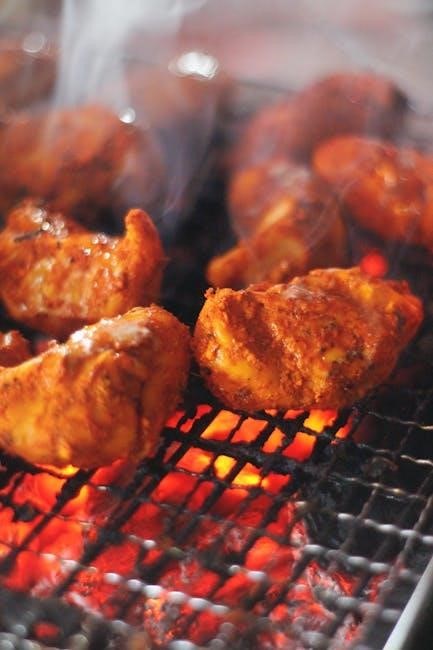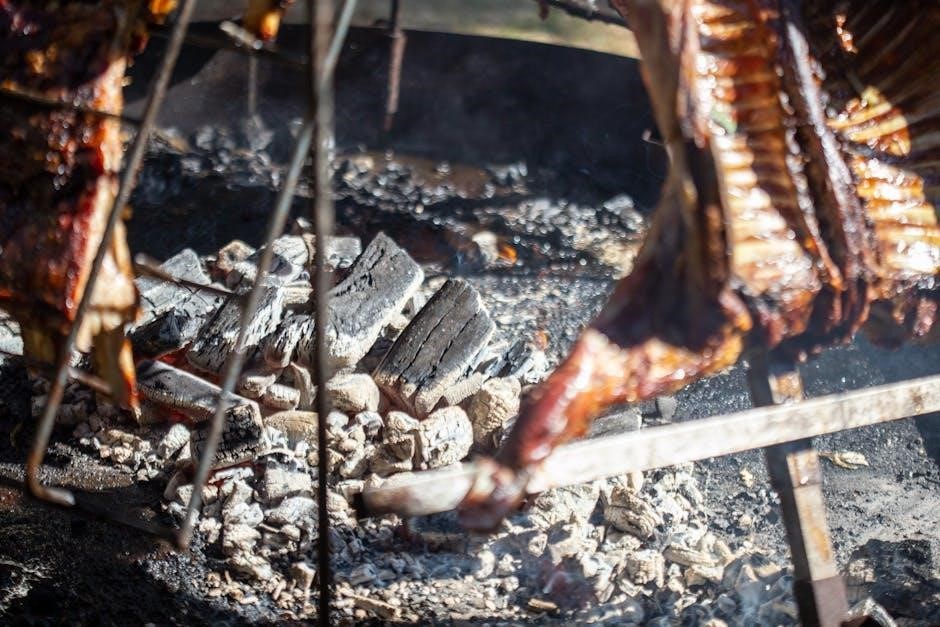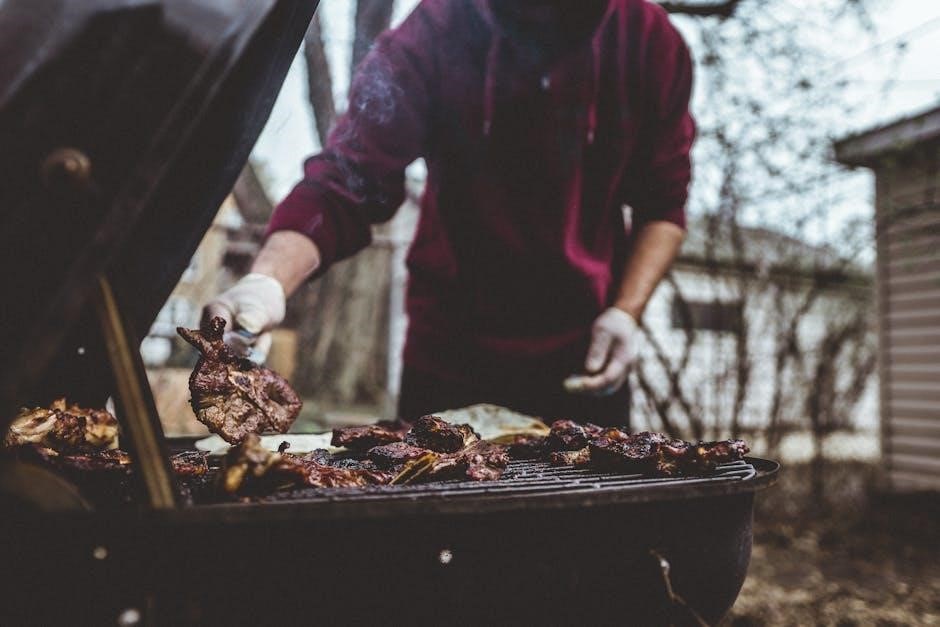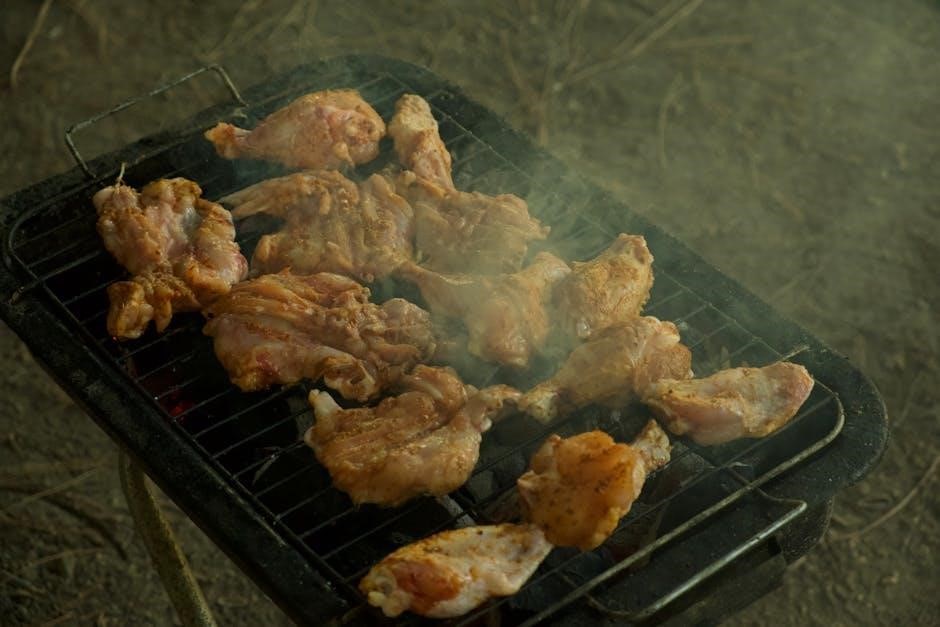
Meat smoking is a culinary art‚ requiring patience and practice‚ with
various techniques
and tools‚ including temperature charts and thermometers‚ to produce delicious and tender results every time perfectly.

What is Meat Smoking
Meat smoking is a process of cooking meat at a low temperature for a long period‚ using smoke to add flavor and preserve the meat. This method has been used for centuries to create tender and delicious dishes.
Smoking meat involves exposing the meat to smoke from burning wood or other plant materials‚ which infuses the meat with a rich and savory flavor.
The smoke also helps to break down the connective tissues in the meat‚ making it tender and easy to chew.
Meat smoking can be done using various types of equipment‚ including charcoal grills‚ gas grills‚ and specialized smokers.
The key to successful meat smoking is to maintain a consistent temperature and to use the right type of wood for the desired flavor.
With practice and patience‚ anyone can learn the art of meat smoking and create delicious and mouth-watering dishes.
Meat smoking is a popular method of cooking among outdoor enthusiasts and chefs‚ and is often used to cook a variety of meats‚ including brisket‚ ribs‚ and sausage.
Benefits of Meat Smoking
Meat smoking offers several benefits‚ including the ability to preserve meat for a longer period.
The smoking process helps to prevent bacterial growth‚ making it a great way to store meat for later use.
Additionally‚ meat smoking adds a rich and complex flavor to the meat‚ making it a popular choice among chefs and outdoor enthusiasts.
The low heat and slow cooking process also help to break down the connective tissues in the meat‚ making it tender and easy to chew.
Meat smoking is also a great way to cook meat for a large group of people‚ as it allows for a large quantity of meat to be cooked at once.
Overall‚ the benefits of meat smoking make it a popular choice among those who enjoy cooking and eating delicious and flavorful meat.
With its ability to preserve and add flavor to meat‚ meat smoking is a great way to enjoy a variety of dishes‚ from classic barbecue to more exotic flavors.

Equipment Needed for Meat Smoking
Smokers and thermometers are essential tools for meat smoking‚ requiring careful selection and maintenance always.
Smoker Types
There are various types of smokers available‚ including charcoal‚ gas‚ and electric smokers‚ each with its own unique characteristics and advantages. Charcoal smokers are popular for their traditional flavor‚ while gas smokers offer convenience and ease of use. Electric smokers are ideal for beginners‚ as they are easy to operate and require minimal maintenance. Additionally‚ there are also pellet smokers‚ which use compressed wood pellets as fuel‚ and kamado smokers‚ which use a ceramic shell to retain heat. When choosing a smoker‚ it is essential to consider factors such as size‚ material‚ and features‚ to ensure that it meets your specific needs and preferences. Furthermore‚ some smokers come with advanced features‚ such as temperature control and meat probes‚ which can help to achieve perfect results. Overall‚ selecting the right smoker type is crucial for a successful meat smoking experience‚ and can make a significant difference in the quality of the final product.
Thermometers and Temperature Control
Accurate temperature control is crucial in meat smoking‚ and thermometers play a vital role in achieving this. Digital probe thermometers are highly recommended‚ as they provide precise temperature readings and can be easily monitored. These thermometers can be placed in the meat‚ allowing for real-time temperature tracking‚ and some models even come with wireless connectivity and mobile apps. Temperature control systems‚ such as those with PID controllers‚ can also be used to regulate the smoker’s temperature‚ ensuring a consistent and optimal environment for smoking. Additionally‚ some smokers come with built-in thermometers and temperature control features‚ making it easier to monitor and adjust the temperature as needed. By using thermometers and temperature control systems‚ smokers can ensure that their meat is cooked to a safe internal temperature‚ while also achieving the perfect level of doneness and flavor. This is essential for producing high-quality smoked meat.

Meat Preparation and Safety
Proper handling and storage of meat is essential for food safety and quality‚ using
guidelines
and regulations to prevent contamination and spoilage always matters.
Marinating and Seasoning
Marinating and seasoning are crucial steps in preparing meat for smoking‚ as they enhance the flavor and tenderize the meat. A good marinade can add depth and complexity to the meat‚ while seasoning can bring out the natural flavors. When marinating‚ it is essential to use a food-safe container and to refrigerate the meat at a temperature of 40°F or below. The marinade should be turned or massaged into the meat periodically to ensure even distribution of the flavors. For seasoning‚ a blend of spices and herbs can be used to create a dry rub‚ which is then applied to the meat. The type and amount of seasoning will depend on the type of meat being smoked and personal preference. By following these steps‚ the meat will be well-prepared for smoking‚ and the resulting flavor will be rich and satisfying. Proper marinating and seasoning techniques can make a significant difference in the quality of the final product.
Cooking and Storage Guidelines
Cooking and storage guidelines are essential for ensuring the quality and safety of smoked meat. It is crucial to cook the meat to the recommended internal temperature to prevent foodborne illness. The USDA recommends cooking poultry to at least 165°F and ground meats to at least 160°F. After cooking‚ the meat should be stored in a covered container and refrigerated at a temperature of 40°F or below. Smoked meat can be stored in the refrigerator for several days‚ but it is best consumed within a few days for optimal flavor and texture. When storing smoked meat‚ it is essential to keep it away from strong-smelling foods‚ as the meat can absorb odors easily. By following proper cooking and storage guidelines‚ the smoked meat will remain fresh and safe to eat‚ and its flavor and texture will be preserved. Proper storage also helps to maintain the meat’s quality and prevents spoilage.

Smoking Techniques and Tips
Smoking techniques involve using indirect heat‚ with
various methods
and wood types‚ to produce tender and flavorful results always perfectly and easily at home with a smoker.
Direct and Indirect Heat
Understanding the difference between direct and indirect heat is crucial for successful meat smoking. Direct heat is ideal for grilling and searing meat quickly‚ while indirect heat is perfect for smoking. Indirect heat allows the meat to cook slowly and uniformly‚ resulting in tender and flavorful food. This method involves placing the meat away from the heat source‚ allowing the heat and smoke to circulate around it; The use of indirect heat helps to prevent the meat from burning or cooking too quickly‚ and it also allows for a more even distribution of smoke flavor. By using indirect heat‚ smokers can achieve a rich‚ complex flavor profile that is characteristic of slow-cooked meats. With the right combination of heat‚ smoke‚ and time‚ smokers can produce delicious and mouth-watering results that are sure to impress. Proper use of indirect heat is essential for achieving professional-grade smoking results at home.
Smoking Times and Temperatures
Smoking times and temperatures are critical components of the meat smoking process. A digital probe meat thermometer is essential for monitoring the internal temperature of the meat‚ ensuring it reaches a safe minimum temperature. The temperature should always be used to determine when the meat is done cooking‚ rather than relying on time. Different types of meat require specific temperature ranges‚ and it is crucial to follow these guidelines to avoid undercooked or overcooked meat. A temperature chart can be a valuable resource for smokers‚ providing a quick reference guide for various types of meat and their corresponding temperature requirements. By following these temperature guidelines and using a reliable thermometer‚ smokers can achieve perfectly cooked meat every time‚ with a tender and flavorful texture that is sure to impress. Proper temperature control is essential for safe and delicious smoking results‚ and it is a key aspect of the meat smoking process.